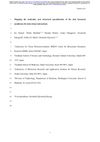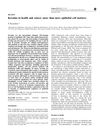Search
forLearn
5 / 8 resultslearn Thymosin Beta 4
learn Osteopontin
signaling protein that, when suppressed, may grow hair by reducing inflammation and stem cell loss
learn Stem Cell Factor
learn Overview
Research
5 / 1000+ results
research Mapping the Molecular and Structural Specialization of the Skin Basement Membrane for Inter-Tissue Interactions
The skin's basement membrane is specially designed to support different types of connections between skin layers and hair follicles.
research Analysis of the Sheep Trichohyalin Gene: Potential Structural and Calcium-Binding Roles of Trichohyalin in the Hair Follicle
Trichohyalin in sheep hair follicles may help with structure and calcium binding.

research Dual Growth Factor Releasing Multi-Functional Nanofibers for Wound Healing
The nanofibers with two growth factors improved wound healing by supporting structure, preventing infection, and aiding tissue growth.

research Keratins in Health and Cancer: More Than Mere Epithelial Cell Markers
Keratins help protect cells, aid in cancer diagnosis, and influence cancer behavior and treatment.
research Keratin Intermediate Filaments in the Colon: Guardians of Epithelial Homeostasis
Keratin proteins are essential for keeping the cells in the human colon healthy and stable.
Community Join
5 / 348 resultscommunity DUPA, Non Responders and Connective Tissue Disorders
A 27-year-old male with diffuse hair loss, including the donor area, did not respond to finasteride, dutasteride, or minoxidil. He suspects his hair loss may be linked to a mild connective tissue disorder, possibly affecting the structural support of hair follicles, rather than being purely hormonal.

community Compressed part of research of theory of androgenic/anabolitic balance. AGA h-responders analytic. Theory of physio-metabolitic method of anti AGA treatment
The treatment for androgenetic alopecia involves using finasteride and minoxidil with intense exercise and cold exposure to boost metabolism and reduce androgenic effects, potentially leading to hair regrowth. This approach may activate biological pathways for improved hair and overall health.
community 21m, curious about what's going on with my hair
A 21-year-old male with a thyroid condition noticed his hair thinning uniformly without a receding hairline. He is considering using a 5ARI to prevent further baldness if he starts TRT.
community Lion Mane Part 2: Microneedling with Topicals, beneficial compounds, maybe?
The conversation discusses microneedling techniques and the use of Minoxidil, copper peptides, EGF, FGF, ceramides, and hydration serums to enhance hair growth. It explores optimizing scalp conditions and the potential benefits of various compounds in conjunction with microneedling.
community Hair Loss Inflammation Prevention Stack
The conversation discusses a hair loss and scalp care routine involving ciclopirox shampoo, benzoyl peroxide, clindamycin gel, clobetasol propionate, and calcipotriol to manage seborrheic dermatitis, folliculitis, and inflammation. It also touches on the role of diet and other treatments like oral minoxidil and pioglitazone for scalp health.